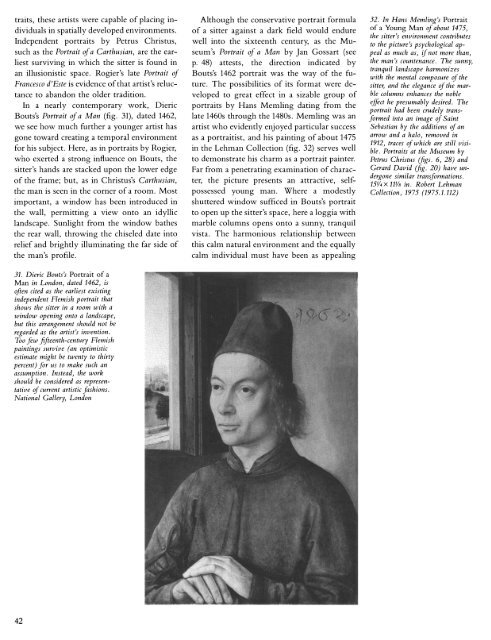Early Flemish Portraits 1425-1525: The Metropolitan Museum of Art ...
Early Flemish Portraits 1425-1525: The Metropolitan Museum of Art ...
Early Flemish Portraits 1425-1525: The Metropolitan Museum of Art ...
Create successful ePaper yourself
Turn your PDF publications into a flip-book with our unique Google optimized e-Paper software.
traits, these artists were capable <strong>of</strong> placing individuals<br />
in spatially developed environments.<br />
Independent portraits by Petrus Christus,<br />
such as the Portrait <strong>of</strong> a Carthusian, are the earliest<br />
surviving in which the sitter is found in<br />
an illusionistic space. Rogier's late Portrait <strong>of</strong><br />
Francesco d'Este is evidence <strong>of</strong> that artist's reluctance<br />
to abandon the older tradition.<br />
In a nearly contemporary work, Dieric<br />
Bouts's Portrait <strong>of</strong> a Man (fig. 31), dated 1462,<br />
we see how much further a younger artist has<br />
gone toward creating a temporal environment<br />
for his subject. Here, as in portraits by Rogier,<br />
who exerted a strong influence on Bouts, the<br />
sitter's hands are stacked upon the lower edge<br />
<strong>of</strong> the frame; but, as in Christus's Carthusian,<br />
the man is seen in the corner <strong>of</strong> a room. Most<br />
important, a window has been introduced in<br />
the wall, permitting a view onto an idyllic<br />
landscape. Sunlight from the window bathes<br />
the rear wall, throwing the chiseled date into<br />
relief and brightly illuminating the far side <strong>of</strong><br />
the man's pr<strong>of</strong>ile.<br />
31. Dieric Bouts's Portrait <strong>of</strong> a<br />
Man in London, dated 1462, is<br />
<strong>of</strong>ten cited as the earliest existing<br />
independent <strong>Flemish</strong> portrait that<br />
shows the sitter in a room with a<br />
window opening onto a landscape,<br />
but this arrangement should not be<br />
regarded as the artist's invention.<br />
Too few fifteenth-century <strong>Flemish</strong><br />
paintings survive (an optimistic<br />
estimate might be twenty to thirty<br />
percent) for us to make such an<br />
assumption. Instead, the work<br />
should be considered as representative<br />
<strong>of</strong> current artistic fashions.<br />
National Gallery, London<br />
Although the conservative portrait formula<br />
<strong>of</strong> a sitter against a dark field would endure<br />
well into the sixteenth century, as the <strong>Museum</strong>'s<br />
Portrait <strong>of</strong> a Man by Jan Gossart (see<br />
p. 48) attests, the direction indicated by<br />
Bouts's 1462 portrait was the way <strong>of</strong> the future.<br />
<strong>The</strong> possibilities <strong>of</strong> its format were developed<br />
to great effect in a sizable group <strong>of</strong><br />
portraits by Hans Memling dating from the<br />
late 1460s through the 1480s. Memling was an<br />
artist who evidently enjoyed particular success<br />
as a portraitist, and his painting <strong>of</strong> about 1475<br />
in the Lehman Collection (fig. 32) serves well<br />
to demonstrate his charm as a portrait painter.<br />
Far from a penetrating examination <strong>of</strong> character,<br />
the picture presents an attractive, selfpossessed<br />
young man. Where a modestly<br />
shuttered window sufficed in Bouts's portrait<br />
to open up the sitter's space, here a loggia with<br />
marble columns opens onto a sunny, tranquil<br />
vista. <strong>The</strong> harmonious relationship between<br />
this calm natural environment and the equally<br />
calm individual must have been as appealing<br />
32. In Hans Memling's Portrait<br />
<strong>of</strong> a Young Man <strong>of</strong> about 1475,<br />
the sitter's environment contributes<br />
to the picture's psychological appeal<br />
as much as, if not more than,<br />
the man's countenance. <strong>The</strong> sunny,<br />
tranquil landscape harmonizes<br />
with the mental composure <strong>of</strong> the<br />
sitter, and the elegance <strong>of</strong> the marble<br />
columns enhances the noble<br />
effect he presumably desired. <strong>The</strong><br />
portrait had been crudely transformed<br />
into an image <strong>of</strong> Saint<br />
Sebastian by the additions <strong>of</strong> an<br />
arrow and a halo, removed in<br />
1912, traces <strong>of</strong> which are still visible.<br />
<strong>Portraits</strong> at the <strong>Museum</strong> by<br />
Petrus Christus (figs. 6, 28) and<br />
Gerard David (fig. 20) have undergone<br />
similar transformations.<br />
15/4 x 111/8 in. Robert Lehman<br />
Collection, 1975 (1975.1.112)<br />
42

















